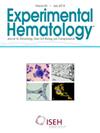KLF4 enhances transplantation-induced hematopoiesis by inhibiting TLRs and noncanonical NFκB signaling at a steady state
IF 2.1
4区 医学
Q2 HEMATOLOGY
引用次数: 0
Abstract
The transcription factor Krüppel-like factor 4 (KLF4) acts as a transcriptional activator and repressor. KLF4 plays a role in various cellular processes, including the dedifferentiation of somatic cells into induced pluripotent stem cells. Although it has been shown to enhance self-renewal in embryonic and leukemia stem cells, its role in adult hematopoietic stem cells (HSCs) remains underexplored. We demonstrate that conditional deletion of the Klf4 gene in hematopoietic cells led to an increased frequency of immunophenotypic HSCs in the bone marrow, along with a normal distribution of lymphoid and myeloid progenitor cells. Noncompetitive bone marrow transplants showed normal engraftment and multilineage reconstitution, except for monocytes and T cells. However, the loss of KLF4 hindered hematologic reconstitution in competitive serial bone marrow transplants, highlighting a critical role for KLF4 in stress-induced hematopoiesis. Transcriptome analysis revealed an upregulation of NFκB2 and toll-like receptors (e.g., TLR4) in Klf4-null HSCs during homeostasis. Flow cytometry and immunoblot analysis confirmed the increased cell surface expression of TLR4 and the activation of NFκB2 in HSCs under homeostatic conditions, whereas NFκB2 expression drops after radiation compared with steady-state levels. Our findings suggest that the constitutive activation of the TLR4–NFκB2 pathway inhibits the ability of HSCs to regenerate blood after transplantation in cytoablated bone marrow.

KLF4通过稳定抑制tlr和非典型NFκB信号传导来促进移植诱导的造血。
转录因子kr样因子4 (KLF4)作为转录激活因子和抑制因子。KLF4在多种细胞过程中发挥作用,包括体细胞向诱导多能干细胞的去分化。虽然它已被证明可以增强胚胎干细胞和白血病干细胞的自我更新,但它在成人造血干细胞(HSC)中的作用仍未被充分探索。我们证明,造血细胞中Klf4基因的条件缺失导致骨髓中免疫表型造血干细胞(hsc)的频率增加,同时淋巴细胞和骨髓祖细胞呈正态分布。除单核细胞和T细胞外,非竞争性骨髓移植显示正常的植入和多系重建。然而,KLF4的缺失阻碍了竞争性系列骨髓移植的血液学重建,这突出了KLF4在应激诱导造血中的关键作用。转录组分析显示,在稳态状态下,klf4缺失的hsc中NFκB2和toll样受体(如TLR4)上调。流式细胞术和免疫印迹分析证实,稳态条件下造血干细胞表面TLR4表达增加,nf - κ b2活化,而辐射后nf - κ b2表达较稳态水平下降。我们的研究结果表明,TLR4-NFκB2通路的组成性激活抑制造血干细胞移植后再生血液的能力。
本文章由计算机程序翻译,如有差异,请以英文原文为准。
求助全文
约1分钟内获得全文
求助全文
来源期刊

Experimental hematology
医学-血液学
CiteScore
5.30
自引率
0.00%
发文量
84
审稿时长
58 days
期刊介绍:
Experimental Hematology publishes new findings, methodologies, reviews and perspectives in all areas of hematology and immune cell formation on a monthly basis that may include Special Issues on particular topics of current interest. The overall goal is to report new insights into how normal blood cells are produced, how their production is normally regulated, mechanisms that contribute to hematological diseases and new approaches to their treatment. Specific topics may include relevant developmental and aging processes, stem cell biology, analyses of intrinsic and extrinsic regulatory mechanisms, in vitro behavior of primary cells, clonal tracking, molecular and omics analyses, metabolism, epigenetics, bioengineering approaches, studies in model organisms, novel clinical observations, transplantation biology and new therapeutic avenues.
 求助内容:
求助内容: 应助结果提醒方式:
应助结果提醒方式:


